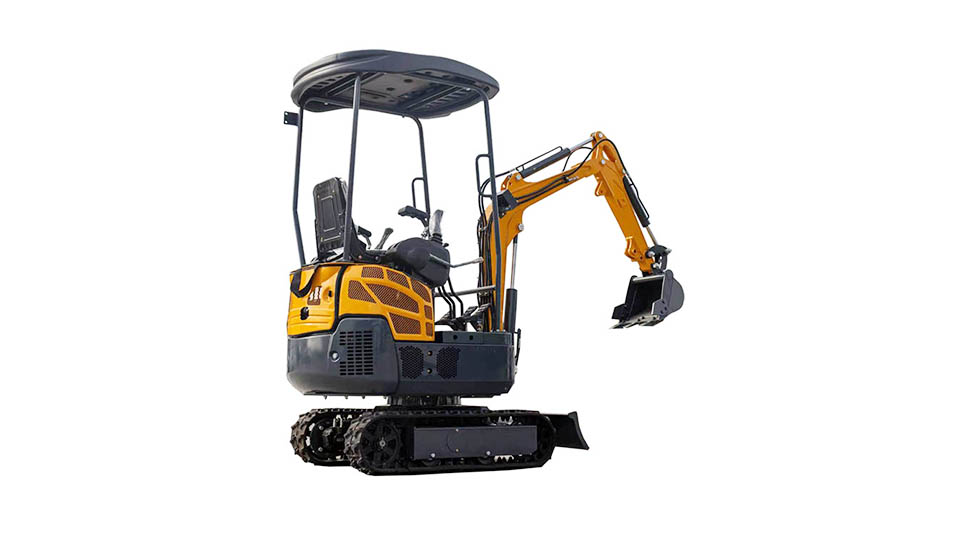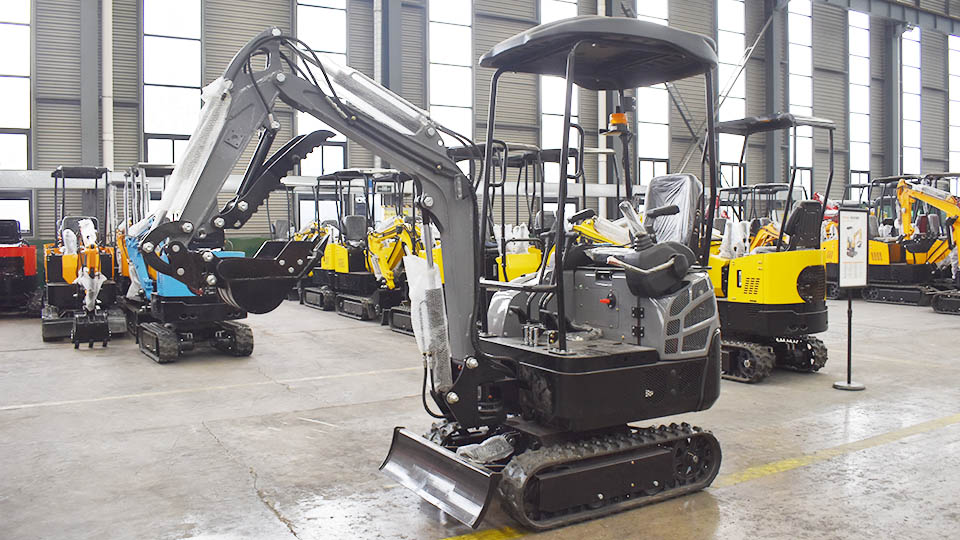An excavator's hydraulic breaker operates by converting the excavator's hydraulic power into a percussive force to break hard materials. It's a powerful and precise tool used in demolition, mining, and construction.
Fundamentals of Hydraulic Breakers
A hydraulic breaker, often called a hydraulic hammer, is an indispensable attachment for excavators and other heavy machinery. Its primary function is to break down materials too hard for traditional digging tools, such as rock, reinforced concrete, or asphalt. Unlike a static force, which a hydraulic cylinder applies to an object, a hydraulic breaker uses a repetitive, high-impact force, which is far more effective for fracturing and breaking materials.
The core principle behind its operation is the conversion of hydraulic pressure from the host machine (the excavator) into kinetic energy. This energy is then transferred to a chisel-like tool, known as a moil point or tool bit, which strikes the target material at a very high frequency. The immense force and rapid succession of impacts cause the material to fracture and break apart.
Key Components and Their Functions
Understanding the internal workings of a hydraulic breaker requires an examination of its key components. While designs may vary between manufacturers, the fundamental parts and their functions remain consistent.

1. The Outer Shell and Mount
The breaker housing is the protective outer casing that encloses all the internal components. It's designed to withstand the harsh working environment and absorb some of the operational vibrations. The housing also includes the mounting bracket, which connects the breaker to the excavator's arm. This bracket is designed to accommodate the specific linkage of the excavator, allowing for precise positioning and a secure connection.
2. The Power Source: Hydraulic System
The breaker is powered by the excavator's hydraulic pump. This pump draws hydraulic fluid (oil) from a reservoir and pressurizes it. The pressurized fluid is then delivered to the breaker through a series of hydraulic hoses and control valves. The pressure and flow rate of the hydraulic fluid are critical to the breaker's performance, determining both the impact force and the frequency of the strikes.
3. The Piston and Ram
At the heart of the hydraulic breaker is the piston, also referred to as the hammer ram. This is a heavy, cylindrical component that moves up and down within the cylinder or body of the breaker. The movement of the piston is what generates the percussive force. The piston is machined to precise tolerances to ensure a tight seal and smooth movement.
4. The Valve System
The control valve is the "brain" of the breaker, directing the flow of hydraulic fluid to control the movement of the piston. The valve system is a complex network of internal channels and spools that alternately feed and vent hydraulic fluid to opposite sides of the piston. This constant redirection of fluid is what causes the piston to reciprocate (move up and down) at a very high speed.
5. The Tool Bit (Moil Point)
The tool bit is the part that makes direct contact with the material being broken. It's a replaceable component, typically made of high-strength steel. The bit's shape can vary depending on the application—a chisel point for cutting through concrete, a moil point for general demolition, or a blunt tool for breaking large rocks. The tool bit is held in place by a retaining pin or bushings that allow it to slide freely but not detach from the breaker.

6. The Accumulator
Many modern hydraulic breakers include an accumulator, a chamber containing a nitrogen gas charge separated from the hydraulic fluid by a diaphragm or piston. The accumulator serves a dual purpose: it acts as a cushion to absorb some of the pressure fluctuations and vibrations generated during operation, protecting the excavator's hydraulic system. It also stores a small amount of pressurized fluid to aid in the return stroke of the piston, enhancing the efficiency and speed of the breaker's cycle.
The Working Principle: A Step-by-Step Breakdown
The operation of a hydraulic breaker can be broken down into a repetitive, three-phase cycle: the charging phase, the striking phase, and the return phase.
Phase 1: The Charging Phase
When the operator activates the breaker, pressurized hydraulic fluid from the excavator's pump flows into the breaker. The fluid is directed by the control valve to the top side of the piston. This high-pressure fluid begins to push the piston upwards, away from the tool bit. As the piston moves up, it compresses the nitrogen gas in the accumulator (if present) and stores potential energy. This upward movement is also known as the return stroke.
Phase 2: The Striking Phase
Once the piston reaches the top of its stroke, the control valve automatically shifts, rerouting the flow of hydraulic fluid. The high-pressure fluid now enters the lower side of the cylinder, forcing the piston downwards at an incredible speed. This downward movement is aided by the potential energy stored in the accumulator and the weight of the piston itself. The piston accelerates rapidly, converting the stored potential energy and the fluid's pressure into kinetic energy.
Phase 3: The Impact and Return
The piston's downward acceleration culminates in a forceful impact on the top of the tool bit. This kinetic energy is instantly transferred to the tool bit, which in turn delivers a powerful blow to the target material. The impact fractures and breaks the material. Immediately after the impact, the control valve shifts again, beginning the next cycle. The remaining hydraulic fluid is vented back to the reservoir, allowing the piston to start its upward return stroke, and the entire process repeats itself, often at a rate of several hundred to a few thousand times per minute.
The sheer speed of this process is what makes the hydraulic breaker so effective. Each successive blow builds upon the previous one, exploiting the stress fractures created in the material until it shatters.
Types and Classification of Hydraulic Breakers
Hydraulic breakers are not one-size-fits-all tools. They are classified based on several factors, primarily their size, power class, and internal mechanism.
By Size and Power Class
Small Breakers: Typically used on mini-excavators and backhoes, these are ideal for light-duty demolition, such as breaking sidewalks, small concrete slabs, or interior demolition. They are a good fit for residential and urban construction projects.
Medium Breakers: Mounted on standard excavators (around 12-25 tons), these are the most common type. They are highly versatile and used for a wide range of tasks, from breaking up roads and foundations to medium-sized rock breaking.
Large Breakers: These are massive attachments for heavy-duty excavators (over 30 tons). They are designed for large-scale demolition projects, quarrying, and primary rock breaking in mining operations. Their immense power can break apart even the hardest granite or reinforced concrete.
By Internal Mechanism
Diaphragm Breakers: These are a simpler design that uses a gas-charged diaphragm to aid in the piston's return stroke. They are known for their reliability and lower maintenance requirements.
Piston Breakers: More common in larger models, these breakers use a more complex valve and piston system, often incorporating an accumulator, to achieve higher impact energy and frequency. They are generally more efficient and powerful.
Maintenance and Operational Safety
Proper maintenance is crucial for the longevity and performance of a hydraulic breaker. It's a tool that operates under extreme stress, so regular checks are essential.
Essential Maintenance Practices
Daily Inspection: Before each use, check the tool bit for signs of wear or cracks. Ensure the retaining pin is secure and not loose. Inspect the hydraulic hoses for any leaks or damage.
Lubrication: The breaker requires regular lubrication to minimize friction and wear between the piston and the bushings. Most breakers have a centralized greasing point.
Hydraulic Fluid: The quality and cleanliness of the hydraulic fluid are paramount. Contaminated fluid can cause premature wear on the internal components. Regular checks of the excavator's hydraulic system are necessary.
Nitrogen Charge: If the breaker has an accumulator, its nitrogen gas charge needs to be checked periodically. A low charge will reduce the breaker's efficiency and can damage the internal components.
Operational Safety
Operator Training: The operator must be trained in the correct use of the breaker. This includes understanding the correct angles for breaking, avoiding "blank firing" (operating the breaker without contact with the material), and knowing how to handle potential kickback.
Personal Protective Equipment (PPE): Due to the high noise levels and potential for flying debris, operators and nearby personnel must wear appropriate PPE, including hearing protection, safety glasses, and steel-toed boots.
Pre-Site Assessment: A thorough assessment of the worksite is necessary to identify potential hazards, such as buried utilities or unstable structures.
Conclusion: The Power of Precision
The hydraulic breaker is a testament to the power of applied engineering. It takes a continuous, low-force input (the flow of hydraulic fluid) and transforms it into a series of powerful, high-frequency impacts. This conversion process, governed by the intricate dance of valves and a rapidly moving piston, allows a single machine to perform tasks that once required manual labor or explosives. The breaker's ability to precisely and efficiently break down the toughest materials makes it an essential tool for modern construction and demolition, embodying a perfect blend of force and control.
Post time:Sep-25-2020
